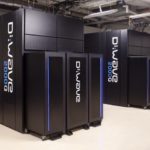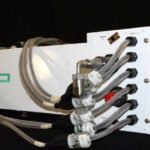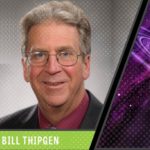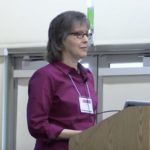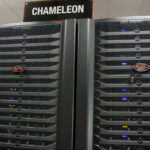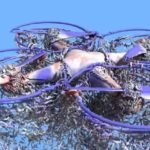Today the Universities Space Research Association (USRA) announced it has upgraded its current quantum annealing computer to a D-Wave 2000Q system. The computer offers the promise for solving challenging problems in a variety of applications including machine learning, scheduling, diagnostics, medicine and biology among others.
Researchers Use TACC, SDSC and NASA Supercomputers to Forecast Corona of the Sun
Predictive Sciences ran a large-scale simulation of the Sun’s surface in preparation for a prediction of what the solar corona will look like during the eclipse. “The Solar eclipse allows us to see levels of the solar corona not possible even with the most powerful telescopes and spacecraft,” said Niall Gaffney, a former Hubble scientist and director of Data Intensive Computing at the Texas Advanced Computing Center. “It also gives high performance computing researchers who model high energy plasmas the unique ability to test our understanding of magnetohydrodynamics at a scale and environment not possible anywhere else.”
Video: HPE goes for Mission to Mars with Supercomputer Launch
“Traveling to Mars and further destinations will require more sophisticated computing capabilities to cut down on communication latencies and ensure astronauts’ survival, but existing computing resources are limited and incapable of extended periods of uptime. Settled aboard the SpaceX Dragon Spacecraft, the Spaceborne Computer is a year-long experiment from HPE and NASA—roughly the amount of time it will take to get to Mars—which will test a supercomputer’s ability to function in the harsh conditions of space.”
Podcast: Why HPC is Vital at NASA
“At NASA, what we’re doing is we’re really looking at ways of making aircraft more efficient. We’re trying to make them quieter. We’re trying to make them get to cruise altitude faster, which saves the taxpayer or the people who are using airplanes a lot of money, and we look at really complex problems. We look at things like rotorcraft. If you think about how that model looks, it’s a very complex model. What do we do with supercomputing? Pretty much everything across the board.”
Evolving Storage and Cyber Infrastructure at the NASA Center for Climate Simulation
Ellen Salmon from NASA gave this talk at the 2017 MSST conference. “This talk will describe recent developments at the NASA Center for Climate Simulation, which is funded by NASA’s Science Mission Directorate, and supports the specialized data storage and computational needs of weather, ocean, and climate researchers, as well as astrophysicists, heliophysicists, and planetary scientists.”
Podcast: PortHadoop Speeds Data Movement for Science
In this TACC Podcast, host Jorge Salazar interviews Xian-He Sun, Distinguished Professor of Computer Science at the Illinois Institute of Technology. Computer Scientists working in his group are bridging the file system gap with a cross-platform Hadoop reader called PortHadoop, short for portable Hadoop. “We tested our PortHadoop-R strategy on Chameleon. In fact, the speedup is 15 times faster,” said Xian-He Sun. “It’s quite amazing.”
NASA Spins Up High Performance Computing Challenge
Today NASA announced a code-speedup contest called the High Performance Fast Computing Challenge (HPFCC). The competition will reward qualified contenders who can manipulate the agency’s FUN3D design software so it runs ten to 10,000 times faster on the Pleiades supercomputer without any decrease in accuracy. “This is the ultimate ‘geek’ dream assignment,” said Doug Rohn, director of NASA’s Transformative Aeronautics Concepts Program (TACP). “Helping NASA speed up its software to help advance our aviation research is a win-win for all.”
Engility Pursues NASA Advanced Computing Services Contract
Today Engility that the company will bring its world-class high performance computing capabilities to bear as it competes to win NASA’s Advanced Computing Services contract. “HPC is a strategic, enabling capability for NASA,” said Lynn Dugle, CEO of Engility. “Engility’s cadre of renowned computational scientists and HPC experts, coupled with our proven high performance data analytics solutions, will help increase NASA’s science and engineering capabilities.”
Quantum Artificial Intelligence Lab to Install D-Wave 2000Q System
Today D-Wave Systems announced that Google, NASA, and Universities Space Research Association (USRA) have elected to upgrade to the new D-Wave 2000Q system. The upgraded system will support research on how quantum computing can be applied to artificial intelligence, machine learning, and difficult optimization problems. The new system will be the third generation of D-Wave technology installed at Ames,” said D-Wave CEO Vern Brownell. “We are pleased that Google, NASA, and USRA value the increased performance embodied in our latest generation of technology, the D-Wave 2000Q system, for their critical applications.”
Supercomputing Drone Aerodynamics
In this video, researchers at NASA Ames explore the aerodynamics of a popular example of a small, battery-powered drone, a modified DJI Phantom 3 quadcopter. “The Phantom relies on four whirring rotors to generate enough thrust to lift it and any payload it’s carrying off the ground. Simulations revealed the complex motions of air due to interactions between the vehicle’s rotors and X-shaped frame during flight. As an experiment, researchers added four more rotors to the vehicle to study the effect on the quadcopter’s performance. This configuration produced a nearly twofold increase in the amount of thrust.”

